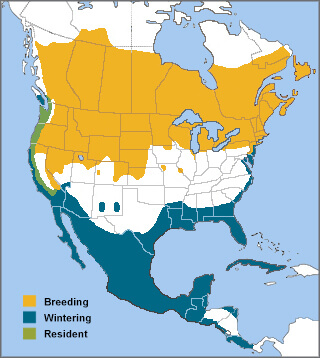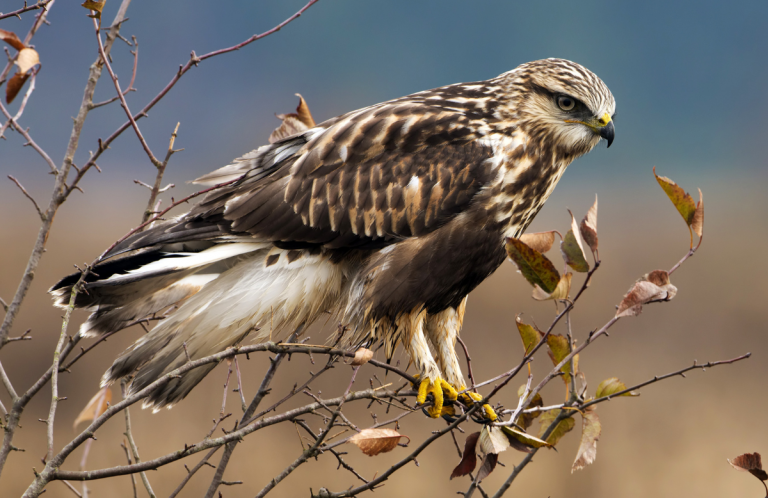
American Bittern range map by American Bird Conservancy
A shy wetland denizen, the chunky, mid-sized American Bittern is more often heard than seen. If spotted and approached, this marsh bird prefers to freeze in place, not fly away as a Green Heron or Great Egret might. Its brown-striped and buff-flecked plumage provides effective camouflage amidst the reeds and tall grasses where it hides; to add to its disguise, the bittern stretches its neck and bill skyward and sways from side to side, imitating waving reeds. But it's the American Bittern's voice that makes it truly remarkable:
"On a warm spring evening, when the waters are teeming with new life and the trees and shrubberies are enlivened by the migrating host of small birds, one loves to linger on its border and listen to the voices of the marsh," wrote ornithologist Arthur Cleveland Bent in his Life Histories of North American Marsh Birds. "Many and varied are the sounds one hears at such a time … above them all in intensity and volume are the loud, guttural pumping notes of the bittern, the weird, wild love notes of the ‘thunder pumper' or ‘stake driver.'"
Voice of the Marsh
The American Bittern's booming calls have earned it many nicknames: belcher-squelcher, mire-drum, slew pumper, bog bull, and dunk-a-doo. To produce these sounds, the male bittern gulps air, inflating his esophagus, then unleashes a loud three-syllable call while throwing his head upward and forward, up to 10 times in a row. These low-pitched calls carry long distances through the thick marsh vegetation. Males most often call at dawn or dusk, to advertise territory or to attract a mate.
(Audio: Ian Cruickshank, XC160043. Accessible at www.xeno-canto.org/160043)
Bitterns on the Move
The American Bittern breeds in large freshwater marshes and wet meadows throughout southern Canada and the northern and central parts of the United States. Most populations are migratory, moving south from September to November to the Gulf and southeastern Atlantic Coast states, Mexico, Central America, and Caribbean islands (where the species is rare). In milder climes, especially along the West Coast, American Bitterns stay in place year-round. Migrant bitterns return to their breeding grounds from February through mid-May, flying at night, alone or in small groups.

American Bittern in flight by Matt Knoth/Shutterstock
Stealthy Stalker
This bittern is a patient hunter, waiting motionless for long periods in order to strike at and capture passing prey with its spear-like bill. It may also slowly stalk along the shoreline. Although its quarry is mostly fish, including small eels, the bittern also eats frogs, watersnakes, insects, salamanders, crayfish, and small rodents.
Like the Barred Owl or Belted Kingfisher that may share its habitat, the American Bittern regurgitates, in pellet form, indigestible materials such as the outer shells, or exoskeletons, of crayfish.
Staking a Claim
The male American Bittern defends a nesting territory within dense marsh or wet meadow habitat, attracting one or more females to nest there. As part of his threat display, a male defending territory erects long, white plumes on his shoulders that nearly meet across the back like a ruff. Then he stands guard in a threatening posture or stalks the intruder in an intimidating crouch.
The male defends the nesting territory, but does not help with incubation or care of the young. The female builds a platform nest only about six inches above the water's surface, made of marsh vegetation and lined with grasses. She incubates her clutch of two to six eggs for close to a month, then feeds the young after hatching. Young bitterns leave the nest after a week or two, but stay close by and are fed until they are about a month old.
Keeping Bitterns Booming
Its retiring ways make it difficult to monitor, but the American Bittern is suspected to be declining, largely due to loss and degradation of its wetland habitats. Another threat to this species and other waterbirds, such as the King Rail, comes from pesticides, which leach into the birds' habitats, causing contamination and possibly a drop in available invertebrate prey.
National wildlife refuges and other protected areas provide key strongholds for this wetland species. Protection and restoration of large wetlands are critical to keep populations of this remarkable bird healthy and booming.
Donate to support ABC's conservation mission!



















































